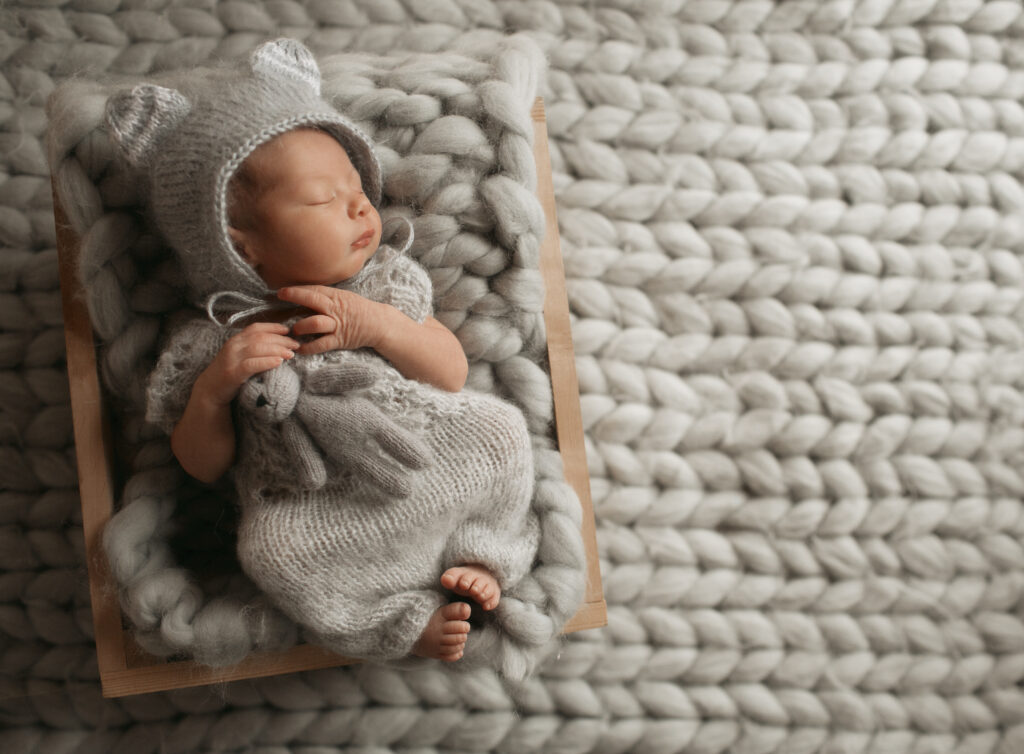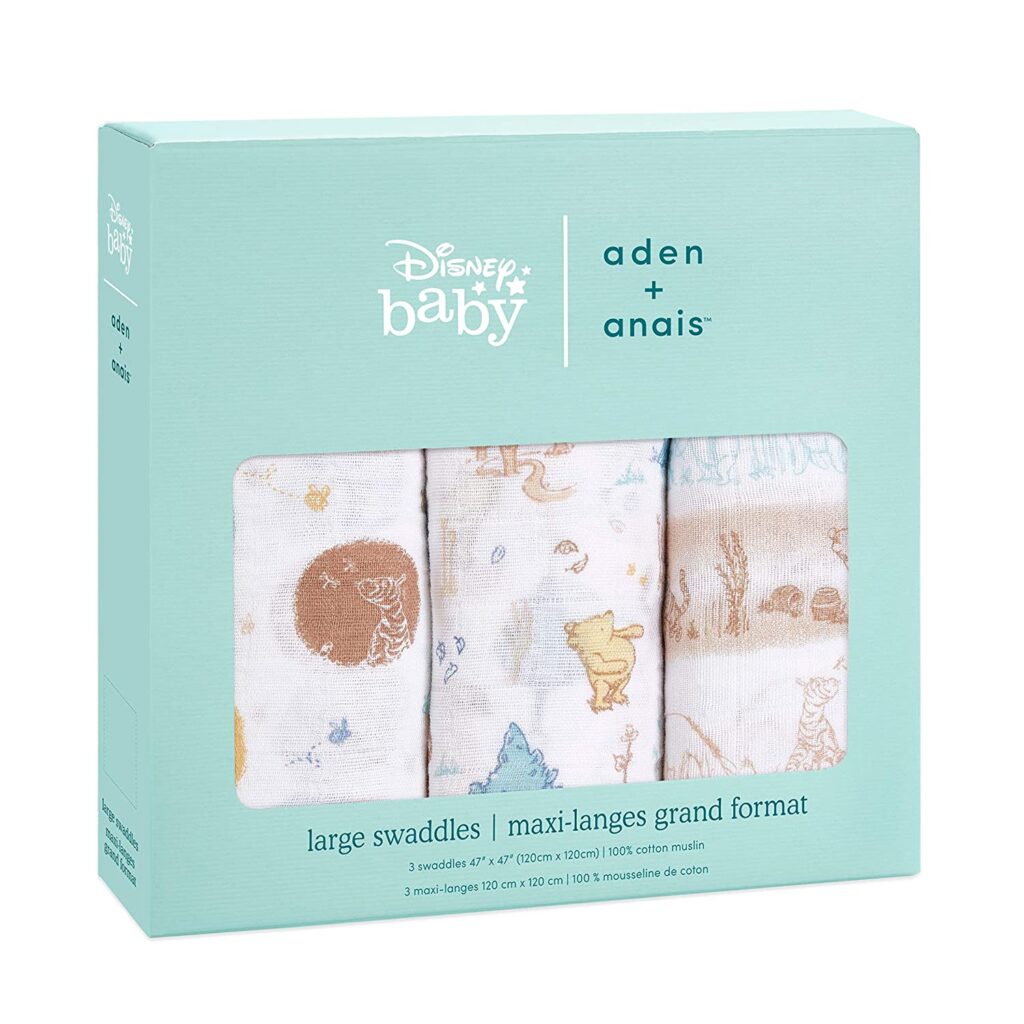
1. Factors to consider
Safety
When choosing a blanket for your newborn, safety is paramount. Make sure the blanket is made with non-flammable materials and free of harmful chemicals. Additionally, check that it doesn’t have small detachable objects that could pose a choking hazard.
Comfort
Your baby’s comfort is essential. Opt for soft and breathable blankets, such as those made from cotton or bamboo. These materials allow for good temperature regulation and prevent skin irritation.
Practicality
Choose a blanket that’s easy to maintain, machine washable, and quick-drying. Furthermore, it’s helpful to have several blankets to change them regularly.
2. Different types of newborn blankets
Cotton blankets
Cotton is a natural, soft, and hypoallergenic material. Cotton blankets are ideal for sensitive skin and ensure good breathability. They are also easy to care for, as they can be machine-washed and dry quickly.
Bamboo blankets
Bamboo blankets are eco-friendly and durable. Bamboo is a highly absorbent material that helps regulate moisture and temperature. Additionally, it has natural antibacterial and odor-resistant properties, making it an excellent choice for newborns.
Wool blankets
Wool is a natural and insulating material that helps keep your baby warm. Wool blankets are particularly suitable for winter months. However, they may be more challenging to maintain than cotton or bamboo blankets.
Fleece blankets
Fleece blankets are lightweight and warm, making them ideal for cold months. They are also easy to maintain and dry quickly. However, fleece is a synthetic material, which may be less suitable for sensitive skin.
3. Best brands of newborn blankets
Aden + Anais

BabyMoov
BabyMoov offers a wide range of baby blankets, from cotton blankets to fleece ones. Their products are of high quality and durability, making them an excellent choice for your newborn.
Red Castle
Red Castle is a French brand specializing in baby products, including a variety of newborn blankets. Their blankets are known for their comfort, quality, and stylish designs, catering to different needs and preferences.
4. How to choose the right size and weight
Size
When selecting a blanket for your newborn, consider the size. Blankets come in various dimensions, so it’s essential to choose one that’s suitable for your baby’s age and size. For newborns, it’s best to opt for a smaller blanket, around 30×40 inches, which is easier to wrap around the baby without being too bulky.
Weight
The weight of the blanket is another essential factor to consider. Lightweight blankets are more suitable for warmer weather, while heavier blankets provide extra warmth in colder months. It’s a good idea to have a variety of blankets with different weights to accommodate the changing seasons and your baby’s needs.
5. Swaddling blankets vs. regular blankets
Swaddling blankets
Swaddling blankets are specially designed to wrap your newborn snugly, providing a sense of security and comfort. Swaddling can help soothe a fussy baby, promote better sleep, and reduce the risk of Sudden Infant Death Syndrome (SIDS). Swaddling blankets are typically made from lightweight, stretchy materials like cotton or bamboo and have a square or rectangular shape.
Regular blankets
Regular blankets, on the other hand, are not specifically designed for swaddling and come in various materials, sizes, and weights. They can be used to keep your baby warm, as a play mat, or for additional padding in a stroller or car seat. While regular blankets can also be used for swaddling, it’s essential to ensure they are lightweight, breathable, and the right size to prevent overheating or suffocation risks.
6. Tips for using newborn blankets safely
Proper swaddling technique
If you choose to swaddle your baby, learn the correct technique to ensure your baby’s safety and comfort. Wrap the blanket snugly around your baby, but not too tight to restrict movement or circulation.
Avoid overheating
Overheating can be dangerous for newborns, so always monitor your baby’s temperature when using a blanket. Choose a lightweight, breathable material, and ensure the room temperature is comfortable. If your baby is sweating or their chest feels hot, remove the blanket or switch to a lighter one.
Place baby on their back
Always place your baby on their back to sleep, especially when using a blanket. This position reduces the risk of SIDS and ensures your baby can breathe easily.
7. Popular features and accessories for newborn blankets
Hooded blankets
Hooded blankets provide extra warmth and coziness for your newborn, covering their head and protecting them from cold drafts. These blankets are particularly useful for outdoor use or during the winter months.
Wearable blankets
Wearable blankets, also known as sleep sacks, are a safe alternative to traditional blankets, reducing the risk of SIDS. They are designed like a sleeping bag, allowing your baby to move freely without getting tangled in a blanket. Wearable blankets are available in various materials and weights to suit different seasons and preferences.
Personalized blankets
Many brands offer the option to personalize your baby’s blanket with their name or initials. Personalized blankets make a thoughtful gift and can become a cherished keepsake for years to come.
Blanket sets
Blanket sets often include multiple blankets with coordinating colors and patterns. These sets can be a cost-effective option for parents looking to build their collection of baby blankets.
8. How to care for your newborn’s blankets
Washing instructions
Always follow the manufacturer’s washing instructions to maintain the quality and longevity of your baby’s blankets. Most blankets can be machine washed, but some may require gentle cycles or specific detergents to prevent damage.
Drying
Ensure that the blankets are completely dry before using them. Some blankets can be tumble dried, while others may require air drying. Check the care label for specific drying instructions.
Storage
Store your baby’s blankets in a clean, dry, and cool place when not in use. Keep them folded or rolled up in a designated storage area to prevent damage and maintain their cleanliness.
9. Making an informed decision
By considering the factors discussed in this guide, you can make an informed decision when choosing the perfect blanket for your newborn. Prioritize safety, comfort, and practicality while exploring different materials, brands, and features. With a variety of blankets on hand, you’ll be prepared to keep your baby warm, cozy, and safe in any situation.
10. DIY and homemade newborn blanket
DIY knitted or crocheted blankets
If you’re skilled in knitting or crocheting, consider creating a unique, homemade blanket for your newborn. Choose soft, baby-friendly yarns, such as cotton or bamboo, to create a cozy and comfortable blanket. Homemade blankets can become cherished keepsakes, passed down through generations.
No-sew fleece blankets
No-sew fleece blankets are an easy and budget-friendly option for those who don’t have knitting or sewing skills. To make a no-sew fleece blanket, you’ll need two pieces of fleece fabric, scissors, and a ruler. Cut the fleece to the desired size, then create fringes around the edges and tie them together for a snug, warm blanket.
Quilted blankets
Quilted blankets are another option for a homemade newborn blanket. If you have sewing skills, you can create a patchwork quilt using various fabrics, colors, and patterns. Quilted blankets provide warmth and comfort while adding a personal touch to your baby’s nursery.
11. Blankets as thoughtful gifts
Baby shower gifts
Newborn blankets make excellent baby shower gifts, as they are both practical and sentimental. Choose a blanket that reflects the parents’ tastes, or opt for a personalized blanket for a unique and meaningful present.
Welcome home gifts
When a newborn arrives home, a cozy and comfortable blanket can be a wonderful welcome home gift. Parents will appreciate the thoughtfulness, and the blanket will become a cherished part of the baby’s early days.
Heirloom blankets
Heirloom blankets, such as hand-knitted, crocheted, or quilted blankets, can be passed down through generations, making them an especially thoughtful gift. Choose high-quality materials and timeless designs to ensure the blanket’s longevity.
Conclusion
Choosing the best blanket for your newborn involves considering factors such as safety, comfort, and practicality. There are various types of blankets, materials, and brands available to suit your baby’s needs and preferences. Homemade blankets or thoughtful gifts can add a personal touch and create lasting memories. By following this comprehensive guide, you’ll be well-equipped to select the perfect blanket for your newborn, ensuring their warmth, comfort, and safety




